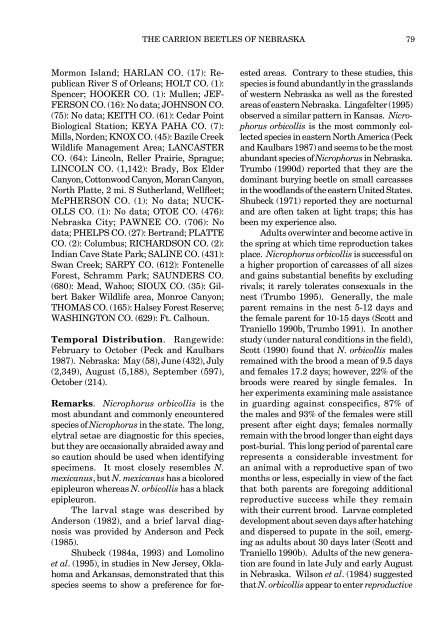Download full text - University of Nebraska State Museum
Download full text - University of Nebraska State Museum
Download full text - University of Nebraska State Museum
You also want an ePaper? Increase the reach of your titles
YUMPU automatically turns print PDFs into web optimized ePapers that Google loves.
Mormon Island; HARLAN CO. (17): Republican<br />
River S <strong>of</strong> Orleans; HOLT CO. (1):<br />
Spencer; HOOKER CO. (1): Mullen; JEF-<br />
FERSON CO. (16): No data; JOHNSON CO.<br />
(75): No data; KEITH CO. (61): Cedar Point<br />
Biological Station; KEYA PAHA CO. (7):<br />
Mills, Norden; KNOX CO. (45): Bazile Creek<br />
Wildlife Management Area; LANCASTER<br />
CO. (64): Lincoln, Reller Prairie, Sprague;<br />
LINCOLN CO. (1,142): Brady, Box Elder<br />
Canyon, Cottonwood Canyon, Moran Canyon,<br />
North Platte, 2 mi. S Sutherland, Wellfleet;<br />
McPHERSON CO. (1): No data; NUCK-<br />
OLLS CO. (1): No data; OTOE CO. (476):<br />
<strong>Nebraska</strong> City; PAWNEE CO. (706): No<br />
data; PHELPS CO. (27): Bertrand; PLATTE<br />
CO. (2): Columbus; RICHARDSON CO. (2):<br />
Indian Cave <strong>State</strong> Park; SALINE CO. (431):<br />
Swan Creek; SARPY CO. (612): Fontenelle<br />
Forest, Schramm Park; SAUNDERS CO.<br />
(680): Mead, Wahoo; SIOUX CO. (35): Gilbert<br />
Baker Wildlife area, Monroe Canyon;<br />
THOMAS CO. (165): Halsey Forest Reserve;<br />
WASHINGTON CO. (629): Ft. Calhoun.<br />
Temporal Distribution. Rangewide:<br />
February to October (Peck and Kaulbars<br />
1987). <strong>Nebraska</strong>: May (58), June (432), July<br />
(2,349), August (5,188), September (597),<br />
October (214).<br />
Remarks. Nicrophorus orbicollis is the<br />
most abundant and commonly encountered<br />
species <strong>of</strong> Nicrophorus in the state. The long,<br />
elytral setae are diagnostic for this species,<br />
but they are occasionally abraided away and<br />
so caution should be used when identifying<br />
specimens. It most closely resembles N.<br />
mexicanus, but N. mexicanus has a bicolored<br />
epipleuron whereas N. orbicollis has a black<br />
epipleuron.<br />
The larval stage was described by<br />
Anderson (1982), and a brief larval diagnosis<br />
was provided by Anderson and Peck<br />
(1985).<br />
Shubeck (1984a, 1993) and Lomolino<br />
et al. (1995), in studies in New Jersey, Oklahoma<br />
and Arkansas, demonstrated that this<br />
species seems to show a preference for for-<br />
THE CARRION BEETLES OF NEBRASKA 79<br />
ested areas. Contrary to these studies, this<br />
species is found abundantly in the grasslands<br />
<strong>of</strong> western <strong>Nebraska</strong> as well as the forested<br />
areas <strong>of</strong> eastern <strong>Nebraska</strong>. Lingafelter (1995)<br />
observed a similar pattern in Kansas. Nicrophorus<br />
orbicollis is the most commonly collected<br />
species in eastern North America (Peck<br />
and Kaulbars 1987) and seems to be the most<br />
abundant species <strong>of</strong> Nicrophorus in <strong>Nebraska</strong>.<br />
Trumbo (1990d) reported that they are the<br />
dominant burying beetle on small carcasses<br />
in the woodlands <strong>of</strong> the eastern United <strong>State</strong>s.<br />
Shubeck (1971) reported they are nocturnal<br />
and are <strong>of</strong>ten taken at light traps; this has<br />
been my experience also.<br />
Adults overwinter and become active in<br />
the spring at which time reproduction takes<br />
place. Nicrophorus orbicollis is successful on<br />
a higher proportion <strong>of</strong> carcasses <strong>of</strong> all sizes<br />
and gains substantial benefits by excluding<br />
rivals; it rarely tolerates consexuals in the<br />
nest (Trumbo 1995). Generally, the male<br />
parent remains in the nest 5-12 days and<br />
the female parent for 10-15 days (Scott and<br />
Traniello 1990b, Trumbo 1991). In another<br />
study (under natural conditions in the field),<br />
Scott (1990) found that N. orbicollis males<br />
remained with the brood a mean <strong>of</strong> 9.5 days<br />
and females 17.2 days; however, 22% <strong>of</strong> the<br />
broods were reared by single females. In<br />
her experiments examining male assistance<br />
in guarding against conspecifics, 87% <strong>of</strong><br />
the males and 93% <strong>of</strong> the females were still<br />
present after eight days; females normally<br />
remain with the brood longer than eight days<br />
post-burial. This long period <strong>of</strong> parental care<br />
represents a considerable investment for<br />
an animal with a reproductive span <strong>of</strong> two<br />
months or less, especially in view <strong>of</strong> the fact<br />
that both parents are foregoing additional<br />
reproductive success while they remain<br />
with their current brood. Larvae completed<br />
development about seven days after hatching<br />
and dispersed to pupate in the soil, emerging<br />
as adults about 30 days later (Scott and<br />
Traniello 1990b). Adults <strong>of</strong> the new generation<br />
are found in late July and early August<br />
in <strong>Nebraska</strong>. Wilson et al. (1984) suggested<br />
that N. orbicollis appear to enter reproductive
















